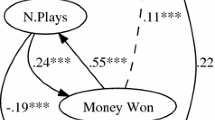Abstract
An experiment tested whether thinking about oneself, particularly in negative terms, increases gambling intensity on Electronic Gaming Machines (EGMs). Forty male and 65 Female participants, aged 18–76 (M = 46.2, SD = 15.3), were recruited through newspaper advertisements to play a laptop simulated EGM in Hervey Bay, Queensland, Australia. Prior to play, subjects in the test conditions audio tape-recorded 2 min of self reflection on either: (1) “things you like about yourself,” or (2) “things you don’t like about yourself.” Immediately after the recordings, the subjects played an EGM that was programmed (rigged) with five wins in the first 20 spins, and indefinite losses thereafter. Participants gambled more intensively in terms of Average Bet Size, Number of Trials Played, and Speed of Betting in the negative self reflection condition compared to the control condition. The experiment supports the proposition that EGM gambling behavior is motivated by escape from negative self reflection.




Similar content being viewed by others
References
Csikszentmihalyi, M. (1991). Flow: The psychology of optimal experience. New York: Harper Collins.
Custer, R. L., & Milt, H. (1985). When luck runs out. New York: Facts on File Publications.
Ferris, J., & Wynne, H. (2001). The Canadian Problem Gambling Index: Final Report. Canadian Centre on Substance Abuse.
Gamblers Anonymous. Official Gamblers Anonymous Home Page. Retrieved 21 September, 2009, from http://www.gamblersanonymous.org/.
Glaser, B. G., & Strauss, A. (1967). The discovery of grounded theory: Strategies for qualitative research. Chicago, IL: Aldine Publishing.
Greenberg, J., & Musham, C. (1981). Avoiding and seeking self-focused attention. Journal of Research in Personality, 15(2), 191–200.
Jacobs, D. F. (1986). A general theory of addictions: A new theoretical model. Journal of Gambling Studies, 2(1), 15–31.
Jacobs, D. F. (1987). Evidence for a common dissociative-like reaction among addicts. Journal of Gambling Behavior, 4, 27–37.
Ledgerwood, D. M., & Petry, N. M. (2006). Psychological experience of gambling and subtypes of pathological gamblers. Psychiatry Research, 144(1), 17–27.
Monaghan, S. (2009). Responsible gambling strategies for Internet gambling: The theoretical and empirical base of using pop-up messages to encourage self-awareness. Computers in Human Behavior, 25(1), 202–207.
Petry, N. M. (2005). Gamblers Anonymous and cognitive-behavioral therapies for pathological gamblers. Journal of Gambling Studies, 21(1), 27.
Rockloff, M. J. (2008). The impact of self-awareness and physiological arousal on EGM gambling behaviour. Brisbane, QLD: Office of Liquor, Gaming and Racing.
Rockloff, M., & Dyer, V. (2006). The Four Es of Problem Gambling: A psychological measure of risk. Journal of Gambling Studies, 22(1), 101–120. doi:10.1007/s10899-005-9005-1.
Rockloff, M., & Dyer, V. (2007). An experiment on the social facilitation of gambling behavior. Journal of Gambling Studies, 23(1), 1–12.
Rockloff, M., & Greer, N. (2010). Never smile at a crocodile: Betting on Electronic Gaming Machines is intensified by reptile-induced arousal. Journal of Gambling Studies. doi:10.1007/s10899-009-9174-4 .
Rockloff, M., Signal, T., & Dyer, V. (2007). Full of sound and fury, signifying something: The impact of autonomic arousal on EGM gambling. Journal of Gambling Studies, 23(4), 457–465.
Silvia, P. J., & Duval, T. S. (2001). Objective self-awareness theory: Recent progress and enduring problems. Personality and Social Psychology Review, 5, 230–241.
Wood, R. T. A., & Griffiths, M. D. (2007). A qualitative investigation of problem gambling as an escape-based coping strategy. Psychology and Psychotherapy: Theory, Research and Practice, 80, 107–125.
Acknowledgment
This research was supported by a grant from the Queensland Treasury Department, Australia.
Author information
Authors and Affiliations
Corresponding author
Rights and permissions
About this article
Cite this article
Rockloff, M.J., Greer, N., Fay, C. et al. Gambling on Electronic Gaming Machines is an Escape from Negative Self Reflection. J Gambl Stud 27, 63–72 (2011). https://doi.org/10.1007/s10899-010-9176-2
Published:
Issue Date:
DOI: https://doi.org/10.1007/s10899-010-9176-2




